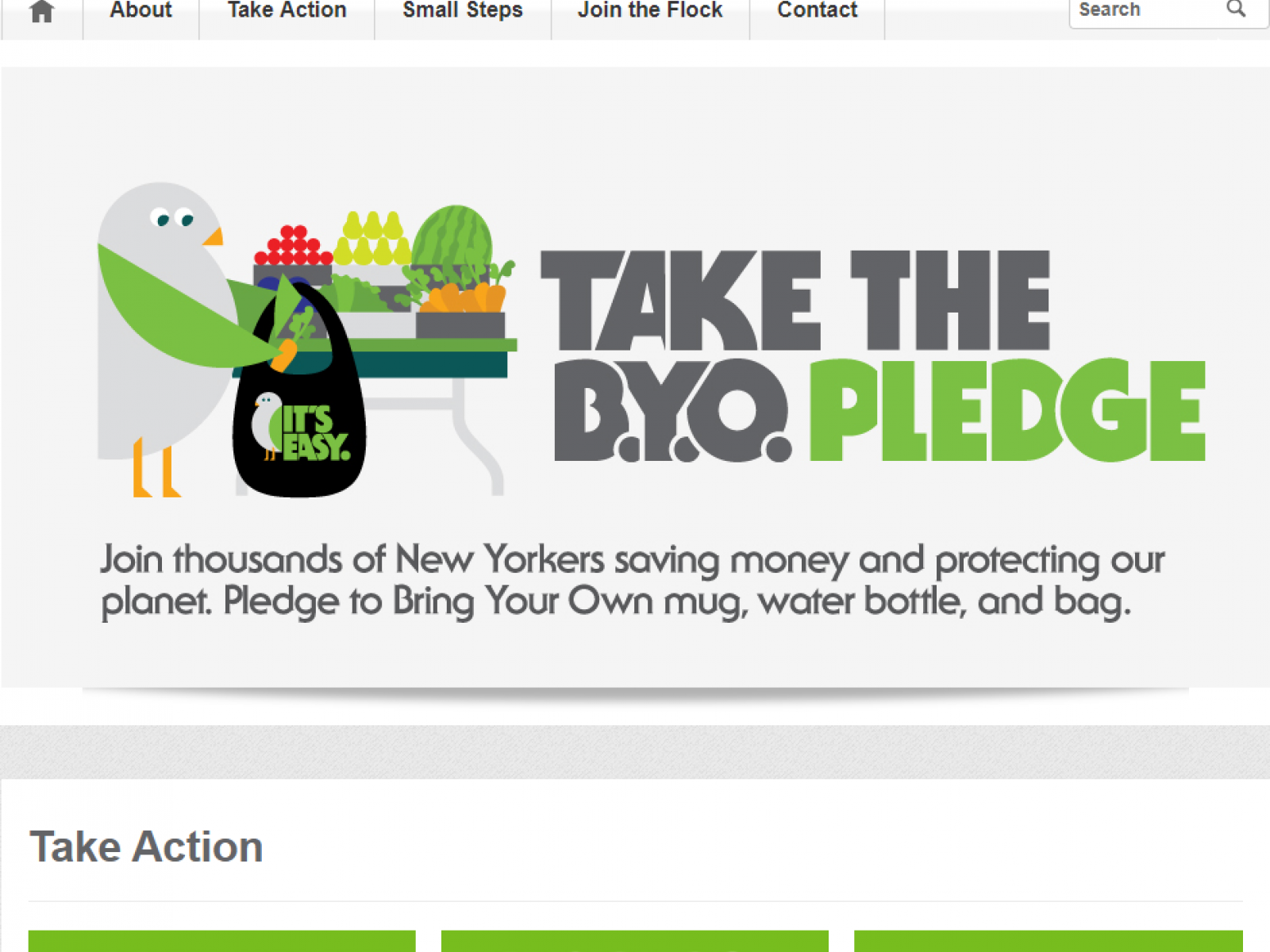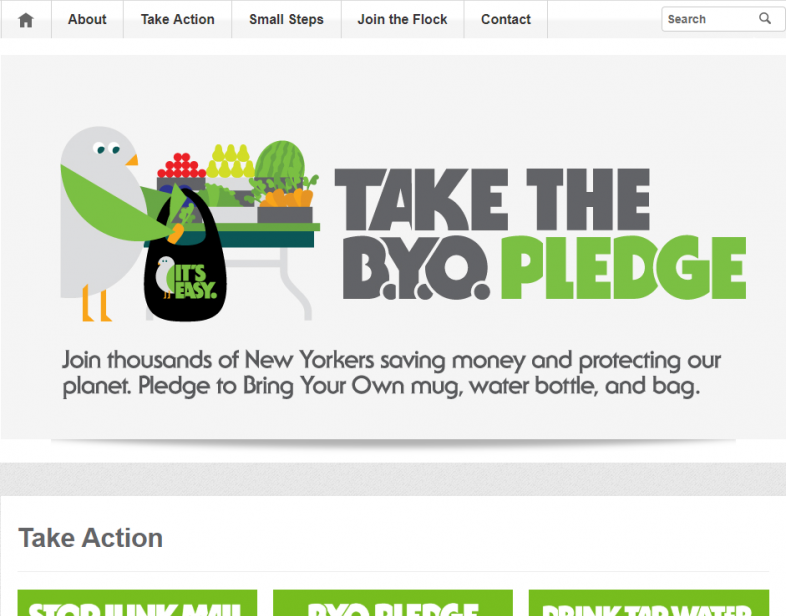An Overview Of Our Solution
GreeNYC is the New York City government’s first program dedicated to mobilizing New Yorkers around sustainability issues. The Bring Your Own program encourages New Yorkers to choose reusable mugs, bags, and bottles over their plastic counterparts. The program runs digital and out-of-home media to educate and engage New Yorkers about single-use plastics and the benefits of reusables, encourages New Yorkers to take the “BYO pledge” to bring their own reusable items, and gives away free items to any New Yorker who takes the pledge.
Our studies have found that New Yorkers value convenience, cost savings, and cleanliness. We have built our campaign to be as simple and intuitive as possible, and centered our communications efforts around messages of public health and cleanliness. As of June 2018, nearly 47,000 people have taken the pledge.
- Population Impacted: 8,500,000 people
- Continent: North America
Last name
Organization type
Context Analysis
New York City produces more waste than any other city on earth, in large part due to reliance on single-use items that are then disposed. More than half a million tons of plastic are thrown out in New York City every year, including 10 billion disposable plastic bags and 1 billion disposable plastic water bottles. The processing, disposal, and decomposition of New York City’s waste generates more than two million metric tons of carbon dioxide every year.
Campaigns in New York City face challenges in gaining public attention, due to the large population and the proliferation of advertisements, information, and existing campaigns. Furthermore, New York City’s population is highly varied in age, race, income level, education level, and more. Wide-spread behavior change campaigns must tailor to specific populations in order to have effective reach.
Describe the technical solution you wanted the target audience to adopt
The most effective approach to waste is to produce less of it. The Bring Your Own campaign encourages New Yorkers to bring a reusable bag, bottle, or mug rather than purchasing disposable equivalents. The campaign centers around a motto of “small steps, big strides,” with the understanding that climate change can feel overwhelming and small steps can create major change. GreeNYC digital and out-of-home media provide tips and tricks to inspire New Yorkers to live more sustainable lives.
Type of intervention
Describe your behavioral intervention
The main behavior we are trying to change is the pattern of using unnecessary things and throwing them away. On a broader level, we are trying to positively engage New York City residents so they feel inspired and empowered to change behaviors, by showing them how small steps can let them make their lives better for themselves and their communities.
Our communications are based on rigorous surveys such as a study by Dalberg Global Development Advisors, which looked at New Yorkers’ environmental behavior and assessed what messages or incentives would motivate change. We learned that New Yorkers already engage in environmental activities and want to do more, but that cost and convenience are the two biggest motivations for changing or failing to change behavior.
Therefore we focus on something straightforward: bags, bottles, and mugs are frequently used and easily replaced with reusable equivalents. We provide the items for free in exchange for taking the “BYO Pledge,” either online or at dozens of events throughout the city. By pairing the promise to use reusables with a free item, we create commitment without inconvenience.
We continue to involve the program on how to better work with New Yorkers to not only take the pledge but also create lasting change.
As needed, please explain the type of intervention in more detail
The BYO campaign rests on the choice architecture logic that small, simple steps are the most easily implemented behavior change. By presenting people with free reusable items and easy, positive change, we offer them easy ways to make their behavior more sustainable.
The GreeNYC brand was conceived to shift away from using shame and fear to drive environmental behavior change, and thereby increase engagement and appeal beyond those already inclined toward green behavior. Our media and items appeal to New York City pride and identity, highlight ways that sustainable behaviors can improve communities, and offer proud statements such as “small steps, big strides” and “I drink New York City tap water” to engage and inspire residents.
Describe your implementation
The primary implementation of the Bring Your Own campaign is straightforward: New Yorkers take a pledge to bring their own reusable bag, bottle, or mug and we provide the item for free. GreeNYC items are given away in return for taking the pledge at events and markets throughout the city, and are also mailed out in return for taking the pledge online.
Key enabling conditions and success factors were New Yorkers’ existing interest in sustainability, the enthusiasm of partners and stakeholders throughout the city, and established recognition of the GreeNYC brand and our mascot Birdie. GreeNYC is a small team with limited capacity, and our partners and volunteers have played an invaluable role in distributing our items and spreading our message.
Out-of-home and paid digital media have spread our message, combining the BYO campaign with other “small steps” tips and tricks for sustainable living, alongside encouraging messages and news about city sustainability efforts.
External connections
GreeNYC relies on an array of partnerships to maximize its reach and impact. It has partnered with private companies like Home Depot and Best Buy, agencies across New York City government such as the Department of Environmental Protection and Department of Sanitation, and NGOs like the environmental defense fund. We have further used our popular brand and bold, creative campaigns to promote the efforts of other city agencies.
GreeNYC complements city policy and infrastructure. New Yorkers’ actions help realize policy goals and fill in gaps created by absent or recently initiated policies. Moreover, individual actions can generate impact quickly and at a lower cost than technological or infrastructure interventions.
Who adopted the desired behaviors and to what degree?
As of June 2018, 46,955 New Yorkers have taken the BYO Pledge. GreeNYC and the NYC Department of Sanitation have handed out more than 550,000 reusable bags and 23,000 reusable bottles.
Paid digital media led to significant increases in both pledges and post engagement – three months of paid digital media led to a 5670% increase in reach and 8254% increase in net likes.
The campaign was well-received, understood, and appreciated by New Yorkers. Surveys during the campaign showed increased awareness of the logos and messaging. The campaign also increased the average self-reported frequency of carrying a reusable bag from two times per week to four, made New Yorkers more aware that they are forgetting to carry shopping bags and water bottles, and avoided the use of over 300 million plastic bags.
How did you impact natural resource use and greenhouse gas emissions?
One person using a reusable water bottle can save 167 plastic bottles per year. Since the average plastic bottle weighs 12.7 grams, this amounts to 4.7 pounds per year. Switching to a reusable bag saves an average of 307 bags per year in the US; in New York this number is likely higher, as residents use more plastic bags per capita. With plastic bags weighing an average of 5.5 grams, each New Yorker switching to reusable bags saves around 4 pounds of plastic per year. With tens of thousands taking the BYO pledge, this quickly adds up.
Over 99% of plastics are derived from fossil fuels; about one ounce of carbon dioxide is emitted for every ounce of plastic produced. Further emissions occur with the transportation, refinement, and manufacturing of petroleum to create bags and bring them to market, and yet more occur when plastics are transported to landfills. Therefore, every choice to bring a reusable rather than plastic is a choice to reduce emissions.
What were some of the resulting co-benefits?
In addition to wasting natural resources and contributing to landfills, single-use plastics propose a public health risk due to small pieces of plastic entering storm drains and ultimately drinking water. Recent studies show that 93% of global bottles water and 94% of local drinking water are contaminated with “microplastics,” pieces of plastic smaller than 5 mm. New York City waterways alone contain 165 million pieces of plastic, 85% of which are microplastics, too small for water filtration systems to catch. The effects on human health are unknown, but it is likely that plastic reduction efforts will improve the cleanliness and health of water.
Reducing waste also improves public cleanliness. In New York City, waste is generally transported through low-income areas, so major waste reduction efforts particularly improve equity and quality of life for lower-income New Yorkers.
Another major co-benefit of reducing plastic use is the protection of biodiversity and particularly marine life, as about 10% of plastic trash ends up in the oceans, where it can suffocate or be ingested by animals.
Sustainability
GreeNYC is primarily funded by city tax levy funding. We coordinate tabling, distribution, and communications with other city agencies such as the Department of Sanitation and the Department of Environmental Protection, and have also explored cost-saving partnerships with private partners.
Return on investment
Although GreeNYC’s annual budget is $1 million, we have generally spent well under our budget. In FY 2018 we spent around $200,000 on reusable giveaway items such as bags and bottles and an additional $42,000 on distribution.
How could we successfully replicate this solution elsewhere?
Other groups have done similar work to us, and GreeNYC has provided a guidebook on our campaigns as well as visited other cities to offer advice on how to run similar ones.


